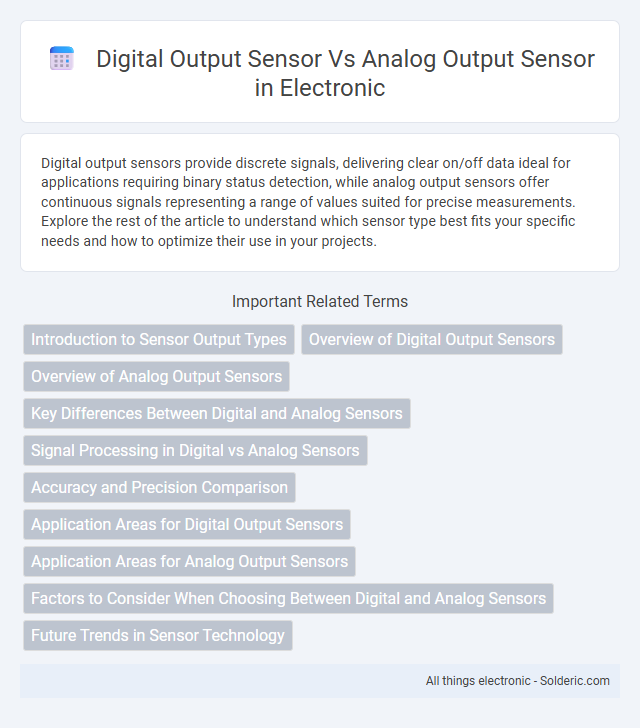Digital output sensors provide discrete signals, delivering clear on/off data ideal for applications requiring binary status detection, while analog output sensors offer continuous signals representing a range of values suited for precise measurements. Explore the rest of the article to understand which sensor type best fits your specific needs and how to optimize their use in your projects.
Comparison Table
| Feature | Digital Output Sensor | Analog Output Sensor |
|---|---|---|
| Signal Type | Discrete (on/off) | Continuous voltage/current |
| Output Range | Binary (0 or 1) | Specific range, e.g., 0-10V, 4-20mA |
| Accuracy | Limited to threshold detection | High resolution, precise measurement |
| Complexity | Simple design | More complex circuitry |
| Signal Processing | Easy digital interpretation | Requires ADC for digital use |
| Noise Sensitivity | Less affected by noise | More sensitive to signal noise |
| Application | Position detection, limit switches | Temperature, pressure, humidity measurement |
| Cost | Generally lower | Often higher |
Introduction to Sensor Output Types
Digital output sensors provide discrete signals, typically in binary form, representing on/off states, making them ideal for applications requiring simple, clear detection such as proximity or limit switches. Analog output sensors deliver continuous signals proportional to the measured parameter, such as temperature or pressure, enabling precise monitoring and control in complex systems. Understanding the difference between your digital and analog sensor outputs ensures accurate integration and optimal performance in your specific application.
Overview of Digital Output Sensors
Digital output sensors convert physical signals into discrete digital signals, typically representing binary values such as ON/OFF or HIGH/LOW. These sensors provide precise and noise-immune data transmission suitable for applications requiring simple status detection or switching functions. Your systems benefit from faster processing and easier integration with digital controllers or microprocessors when using digital output sensors.
Overview of Analog Output Sensors
Analog output sensors provide continuous data signals proportional to physical measurements such as temperature, pressure, or light intensity, enabling precise monitoring and control. Their outputs typically range within voltages like 0-10V or current signals such as 4-20mA, facilitating compatibility with many industrial controllers and data acquisition systems. You can achieve real-time, high-resolution readings with analog sensors, making them essential in applications requiring nuanced measurement variations.
Key Differences Between Digital and Analog Sensors
Digital output sensors provide discrete signals, typically binary, representing specific states such as on/off or presence/absence, while analog output sensors deliver continuous signals corresponding to varying measurement values like temperature or pressure. Digital sensors generally offer higher noise immunity and easier integration with microcontrollers due to their clear, defined signal levels, whereas analog sensors require signal conditioning and analog-to-digital conversion for processing. The choice between digital and analog sensors depends on application requirements for precision, signal complexity, and system compatibility.
Signal Processing in Digital vs Analog Sensors
Digital output sensors convert physical signals into discrete binary data, enabling noise-resistant and precise signal processing through microcontrollers or digital processors. Analog output sensors generate continuous voltage or current that represents the measured parameter, requiring analog-to-digital conversion for further digital processing. Your choice between digital and analog sensors affects the complexity, accuracy, and noise susceptibility of the signal processing system.
Accuracy and Precision Comparison
Digital output sensors provide higher accuracy and precision by delivering discrete binary signals that minimize noise interference and signal degradation during transmission. Analog output sensors generate continuous signals that may be susceptible to environmental noise and signal drift, potentially reducing measurement reliability. Calibration and environmental factors also impact the precision of analog sensors more significantly compared to the robust consistency offered by digital sensors.
Application Areas for Digital Output Sensors
Digital output sensors are widely used in industrial automation, robotics, and smart home systems where precise, binary state detection is critical. These sensors excel in applications requiring simple on/off signals, such as proximity detection, limit switching, and position sensing. Your choice of a digital output sensor ensures fast response times and straightforward integration with microcontrollers and PLCs in manufacturing and security setups.
Application Areas for Analog Output Sensors
Analog output sensors excel in applications requiring continuous and precise measurement of physical parameters such as temperature, pressure, and humidity. They are widely used in industrial automation for process control, HVAC systems for environmental monitoring, and medical devices for patient vital sign tracking. Their ability to provide variable voltage or current signals makes them ideal for integration with analog-to-digital converters in data acquisition and real-time monitoring systems.
Factors to Consider When Choosing Between Digital and Analog Sensors
When choosing between digital output sensors and analog output sensors, factors such as signal accuracy, noise immunity, and compatibility with your data acquisition system are crucial. Digital sensors provide discrete signals that enhance precision and reduce susceptibility to electromagnetic interference, while analog sensors offer continuous data ideal for monitoring variable conditions. Your application's requirements for resolution, range, and integration will determine the optimal sensor type for reliable performance.
Future Trends in Sensor Technology
Future trends in sensor technology emphasize the integration of digital output sensors due to their higher accuracy, ease of data processing, and compatibility with IoT systems, enabling smarter and more connected environments. Analog output sensors continue to evolve with enhanced signal conditioning and noise reduction techniques, but the shift towards digital interfaces supports advanced machine learning algorithms and real-time analytics. Your sensor choices will increasingly favor digital solutions that ensure seamless communication and efficient data utilization in complex industrial and consumer applications.
Digital output sensor vs analog output sensor Infographic

 solderic.com
solderic.com